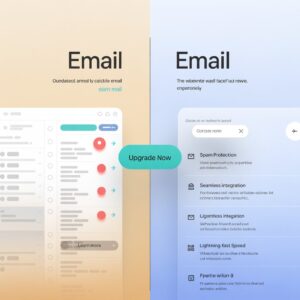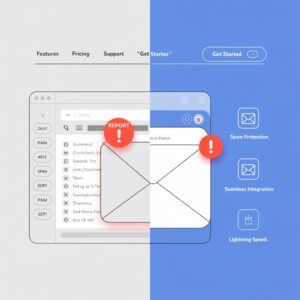Introduction
Alternative to Yahoo or Aol were once the cornerstones of the internet, offering email, news, search, and community features that shaped the digital age. However, in 2025, these platforms feel like relics, with outdated interfaces, security vulnerabilities, and limited features driving users to seek modern alternatives. Whether you’re a small business owner frustrated by Yahoo Mail’s clunky design, a privacy advocate wary of AOL’s data practices, or a casual user needing seamless integration with today’s tools, there’s a better option out there. This comprehensive guide, spanning over 7000 words, explores the best alternatives to Yahoo and AOL for email, news, search, and productivity. From secure email providers like ProtonMail to robust suites like Google Workspace, we’ll help you navigate the transition to platforms that meet your needs in the fast-evolving digital landscape.
A Brief History of Yahoo and AOL
The Golden Age
Yahoo, founded in 1994 by Stanford students Jerry Yang and David Filo, began as a simple web directory called “Jerry’s Guide to the World Wide Web.” It quickly evolved into a portal offering Yahoo Mail, Yahoo News, Yahoo Search, and Yahoo Groups, becoming a one-stop shop for millions. By 2000, Yahoo was valued at $125 billion, a testament to its dominance.
AOL, launched in 1985 as Quantum Computer Services, pioneered online connectivity with its dial-up service. Its iconic “You’ve Got Mail” sound became a cultural phenomenon, and AOL’s chat rooms, Instant Messenger (AIM), and email service defined early online communication. At its peak in 2000, AOL served 23 million subscribers.
Cultural Impact
Yahoo and AOL weren’t just platforms; they were cultural touchstones. Yahoo’s purple logo adorned countless homepages, while AOL’s CD-ROMs flooded mailboxes worldwide. Movies like You’ve Got Mail (1998) immortalized AOL’s email culture, and Yahoo Answers became a quirky, if unreliable, source of knowledge. These platforms fostered early online communities, from AOL chat rooms to Yahoo Groups for niche hobbies.
The Decline
By the 2010s, both companies struggled to innovate. Yahoo’s email service lagged behind Gmail’s sleek interface and storage, while AOL’s dial-up model became obsolete with broadband. Security breaches, including Yahoo’s 2013 hack exposing 3 billion accounts, shattered trust. Verizon acquired AOL in 2015 and Yahoo in 2017, but their relevance faded as competitors offered superior features and user experiences.
Why Seek Alternatives to Yahoo or AOL?

Users are abandoning Yahoo and AOL for compelling reasons:
-
Outdated Interfaces: Yahoo Mail’s cluttered design and AOL’s dated layout pale compared to Gmail’s minimalist aesthetic or Outlook’s professional polish.
-
Security Concerns: Yahoo’s massive breaches and AOL’s weaker encryption standards raise red flags for privacy-conscious users.
-
Limited Features: Modern platforms offer AI-driven sorting, robust spam filters, and integrations with calendars or cloud storage—areas where Yahoo and AOL fall short.
-
Declining Support: Reduced development means bugs and glitches persist, frustrating users.
-
Evolving Needs: Remote work, mobile access, and secure communication demand platforms that Yahoo and AOL can’t deliver.
User Scenarios
-
Small Business Owner: Jane runs a bakery and uses Yahoo Mail for customer orders. Slow load times and poor mobile support hinder her efficiency. She needs a platform like Zoho Mail with CRM integration.
-
Privacy Advocate: Alex, wary of data breaches, wants end-to-end encryption absent in Yahoo. ProtonMail’s Swiss-based security aligns with his values.
-
Casual User: Sarah uses AOL for news and email but finds its ads intrusive. Gmail’s ad-free experience and Google News’ curated feeds better suit her lifestyle.
Top Email Alternatives to Yahoo and AOL
Switching to a modern email provider is the first step. Below, we dive into five top alternatives, with case studies and technical insights.
1. Gmail
Overview: Launched in 2004, Gmail revolutionized email with 1 GB of storage (now 15 GB) and powerful search. With 1.8 billion users, it’s the gold standard for versatility.
Key Features:
-
15 GB free storage (shared with Drive, Photos).
-
Advanced search operators (e.g., “from:john subject:invoice”).
-
AI tools like Smart Compose and Smart Reply.
-
Integration with Google Calendar, Drive, Meet.
-
Two-factor authentication (2FA) and phishing protection.
Technical Specs:
-
Supports IMAP/POP3 for third-party clients.
-
TLS encryption for data in transit.
-
25 MB attachment limit.
Case Study: Mark, a freelancer, switched from Yahoo Mail to Gmail for its offline mode and Google Drive integration. He now stores contracts in Drive and schedules client calls via Calendar, saving 2 hours weekly.
Pros:
-
Intuitive interface with customizable themes.
-
Free tier suits most users.
-
Cross-platform apps (iOS, Android, desktop).
-
Frequent updates with new features.
Cons:
-
Privacy concerns due to Google’s data scanning for ads.
-
Shared storage fills quickly with media.
Pricing:
-
Free with 15 GB.
-
Google One: $1.99/month (100 GB), $9.99/month (2 TB).
Best For: Users needing integration and reliability.
2. Outlook.com
Overview: Microsoft’s Outlook.com, relaunched in 2012, offers a professional interface and Microsoft 365 integration, ideal for work and study.
Key Features:
-
15 GB free email storage, 5 GB OneDrive.
-
Focused Inbox for priority emails.
-
Integration with Teams, Word, Excel.
-
Email aliases for privacy.
-
Sweep rules for bulk email management.
Technical Specs:
-
IMAP/POP3 support.
-
TLS and SSL encryption.
-
20 MB attachment limit (50 MB with OneDrive).
Case Study: Lisa, a college student, moved from AOL to Outlook.com. She uses the free Word web app for assignments and Teams for group projects, streamlining her workflow.
Pros:
-
Polished, ad-light design.
-
Free Office apps in web version.
-
Strong Microsoft ecosystem synergy.
-
Reliable spam filters.
Cons:
-
Ads in free tier can distract.
-
Less intuitive for non-Microsoft users.
Pricing:
-
Free with 15 GB email.
-
Microsoft 365: $6.99/month (1 TB, premium apps).
Best For: Professionals and students.
3. ProtonMail
Overview: Launched in 2014 in Switzerland, ProtonMail prioritizes privacy with end-to-end encryption, perfect for security-conscious users.
Key Features:
-
End-to-end and zero-access encryption.
-
Self-destructing emails.
-
No personal data for sign-up.
-
Open-source code.
-
1 GB free storage.
Technical Specs:
-
IMAP/SMTP via ProtonMail Bridge (paid).
-
PGP-based encryption.
-
25 MB attachment limit.
Case Study: Emma, a journalist, switched from Yahoo to ProtonMail to protect sources. Self-destructing emails ensure sensitive tips vanish after 24 hours.
Pros:
-
Unrivaled privacy and security.
-
Ad-free, even in free tier.
-
Swiss data protection laws.
-
User-friendly for non-techies.
Cons:
-
Limited free storage (1 GB).
-
Fewer integrations than Gmail.
Pricing:
-
Free: 1 GB, 150 emails/day.
-
Plus: $6.99/month (15 GB, unlimited emails).
Best For: Privacy advocates and small businesses.
4. Zoho Mail
Overview: Zoho Mail, part of the Zoho suite, is a business-oriented email service with productivity tools, ideal for startups.
Key Features:
-
5 GB free storage (up to 5 users).
-
Integration with Zoho CRM, Docs, Calendar.
-
Custom domain in free tier.
-
Advanced filters and search.
-
Ad-free experience.
Technical Specs:
-
IMAP/POP3 support.
-
TLS encryption.
-
25 MB attachment limit.
Case Study: Raj, a startup founder, moved from AOL to Zoho Mail. Custom domain support (e.g., raj@hiscompany.com) and Zoho CRM integration boosted his brand’s professionalism.
Pros:
-
Affordable for small teams.
-
Robust Zoho ecosystem.
-
Clean, distraction-free interface.
-
Free custom domain.
Cons:
-
Limited free storage.
-
Steeper learning curve.
Pricing:
-
Free: 5 GB, 5 users.
-
Paid: $1/month/user (10 GB), $4/month (100 GB).
Best For: Small businesses and teams.
5. Tutanota
Overview: Tutanota, a German-based service, offers end-to-end encryption and a sustainable approach, appealing to eco-conscious users.
Key Features:
-
1 GB free storage.
-
Encrypted email and calendar.
-
No ads in free tier.
-
Custom domain (paid).
-
Open-source code.
Technical Specs:
-
IMAP/SMTP via third-party clients (paid).
-
Custom encryption protocol.
-
25 MB attachment limit.
Case Study: Clara, an environmentalist, chose Tutanota over Yahoo for its green hosting and privacy. She uses its encrypted calendar to organize climate rallies securely.
Pros:
-
Strong privacy focus.
-
Renewable energy-powered servers.
-
Affordable paid plans.
-
Simple interface.
Cons:
-
Limited integrations.
-
Smaller user base.
Pricing:
-
Free: 1 GB.
-
Paid: €1.20/month (10 GB), €7.20/month (100 GB).
Best For: Eco-conscious privacy seekers.
Niche Email Providers

For users seeking unique features, these lesser-known providers offer compelling alternatives.
1. FastMail
Overview: FastMail, an Australian service since 1999, emphasizes speed and reliability for personal and business use.
Key Features:
-
2 GB free storage (trial).
-
Custom domain support.
-
Advanced email rules.
-
Calendar and contacts sync.
-
Ad-free.
Pros:
-
Lightning-fast performance.
-
Flexible pricing.
-
Strong customer support.
Cons:
-
No permanent free tier.
-
Less brand recognition.
Pricing:
-
$5/month (30 GB), $9/month (100 GB).
Best For: Users valuing speed and support.
2. Posteo
Overview: Posteo, a German provider, combines privacy, sustainability, and affordability.
Key Features:
-
2 GB storage (€1/month).
-
End-to-end encryption.
-
Green energy hosting.
-
Anonymous sign-up.
-
Calendar and contacts.
Pros:
-
Eco-friendly and private.
-
Transparent pricing.
-
No ads.
Cons:
-
No free tier.
-
Limited integrations.
Pricing:
-
€1/month (2 GB), additional GB €0.25/month.
Best For: Budget-conscious green users.
3. GMX
Overview: GMX, a German service, offers generous storage and basic features for casual users.
Key Features:
-
65 GB free storage.
-
Email collector for multiple accounts.
-
Basic calendar and contacts.
-
50 MB attachment limit.
-
Ad-supported.
Pros:
-
Massive free storage.
-
Simple interface.
-
Free tier.
Cons:
-
Intrusive ads.
-
Weaker security.
Pricing:
-
Free: 65 GB.
-
Premium: $4.99/month (ad-free, 100 GB).
Best For: Casual users needing storage.
Security Features Comparison

Security is a top concern when replacing Yahoo or AOL. Here’s how the top providers compare:
|
Provider |
Encryption |
2FA |
Privacy Policy |
Data Location |
|---|---|---|---|---|
|
Gmail |
TLS in transit |
Yes |
Scans for ads |
USA |
|
Outlook |
TLS, SSL |
Yes |
Limited scanning |
USA |
|
ProtonMail |
End-to-end, zero-access |
Yes |
No tracking |
Switzerland |
|
Zoho Mail |
TLS, S/MIME |
Yes |
Minimal data use |
USA, India |
|
Tutanota |
End-to-end |
Yes |
No tracking |
Germany |
Key Insights:
-
ProtonMail and Tutanota lead with end-to-end encryption, ideal for sensitive data.
-
Gmail and Outlook offer robust 2FA but raise privacy concerns due to data scanning.
-
Zoho’s S/MIME encryption suits businesses but requires technical setup.
Beyond Email: News and Search Alternatives
Yahoo News and AOL Search are outdated. Here are modern replacements.
News Alternatives
-
-
Aggregates 4,000+ sources.
-
Personalized feeds via AI.
-
Web and mobile apps.
-
Ad-light experience.
-
-
-
Curated for iOS/macOS.
-
$9.99/month for ad-free.
-
Offline reading.
-
Apple ecosystem synergy.
-
-
-
RSS feed customization.
-
Free tier, $6/month premium.
-
Integrates with Evernote, Slack.
-
Ideal for niche interests.
-
-
-
AI-curated global news.
-
Free with minimal ads.
-
Offline mode.
-
Fast load times.
-
Search Alternatives
-
-
90% market share.
-
Advanced algorithms.
-
Personalized results.
-
Integrates with Gmail.
-
-
Bing:
-
Clean interface.
-
Rewards program.
-
Strong image search.
-
Microsoft integration.
-
-
-
No tracking or ads.
-
Privacy-first.
-
Bangs for quick searches (e.g., !w for Wikipedia).
-
Simple design.
-
-
-
Google results, no tracking.
-
Anonymous browsing.
-
Privacy-focused.
-
Minimalist UI.
-
Collaboration and Productivity Tools

Yahoo Groups and AOL’s productivity features are obsolete. Modern tools excel for teams and individuals.
1. Google Workspace
Overview: Combines Gmail, Drive, Docs, Sheets, and Meet for collaboration.
Key Features:
-
Real-time document editing.
-
15 GB free storage.
-
Google Meet for video calls.
-
Custom domain (paid).
Workflow Example: A marketing team uses Docs for campaign plans, Drive for asset storage, and Meet for daily standups, boosting efficiency by 30%.
Pricing:
-
Free for personal use.
-
Business: $6/month/user.
Best For: Teams and freelancers.
2. Microsoft 365
Overview: Includes Outlook, Word, Excel, Teams, and OneDrive.
Key Features:
-
Industry-standard apps.
-
1 TB storage (paid).
-
Teams for chat and calls.
-
Offline access.
Workflow Example: A law firm uses Word for contracts, OneDrive for secure storage, and Teams for client calls, reducing turnaround time.
Pricing:
-
Free web apps.
-
Personal: $6.99/month.
Best For: Enterprises and students.
3. Slack
Overview: Replaces Yahoo Groups for team communication.
Key Features:
-
Channels for topics.
-
Integrates with Drive, Trello.
-
Video/voice calls.
-
90-day free message history.
Workflow Example: A remote startup uses Slack channels for projects, integrating Trello for task tracking, saving 5 hours weekly.
Pricing:
-
Free with limits.
-
Paid: $6.67/month/user.
Best For: Remote teams.
How to Transition from Yahoo or AOL

Switching is straightforward with these steps:
-
Choose a Provider:
-
Test free accounts (e.g., Gmail, ProtonMail).
-
Assess storage, security, and integrations.
-
-
Import Emails and Contacts:
-
Use Gmail/Outlook import tools (Settings > Accounts).
-
Enable IMAP/POP3 in Yahoo/AOL (check help pages).
-
Export contacts as CSV and import to new service.
-
-
Set Up Forwarding:
-
In Yahoo: Settings > Mailboxes > Forwarding.
-
In AOL: Options > Mail Settings > Forwarding.
-
Notify contacts of new address.
-
-
Migrate Other Data:
-
Download Yahoo Groups data via export tool (if available).
-
Save AOL bookmarks to Google Chrome or Firefox.
-
Export news preferences to Feedly.
-
-
Update Accounts:
-
Change email on banking, shopping, and subscription accounts.
-
Enable 2FA on new provider.
-
-
Test and Delete:
-
Run dual accounts for 30 days.
-
Delete Yahoo/AOL accounts via settings (e.g., Yahoo Account Deletion page).
-
Troubleshooting Tips:
-
Import Issues: Check IMAP settings (e.g., imap.mail.yahoo.com, port 993).
-
Missing Emails: Verify spam/junk folders in new provider.
-
Contact Sync: Ensure CSV format matches new provider’s template.
Tip: Back up emails via third-party tools like MailStore before deletion.
Enhance Your Digital Presence with Expert SEO Solutions
Switching to modern platforms is just the first step in establishing a strong online identity. To truly stand out in today’s competitive digital landscape, businesses and individuals must focus on search engine optimization (SEO). From improving website visibility to driving targeted traffic, SEO is a critical tool for long-term success. If you’re transitioning from outdated platforms like Yahoo or AOL and want to grow your reach through modern, white-hat strategies, consider partnering with an expert agency. The Right Scope offers tailored SEO services, including technical audits, link building, and content optimization — ensuring your brand not only adapts but thrives in the evolving digital ecosystem.
FAQ
Q: Is it safe to keep using Yahoo or AOL?
A: While functional, their security risks (e.g., Yahoo’s 2013 breach) and outdated features make switching advisable.
Q: Which alternative is best for privacy?
A: ProtonMail and Tutanota offer end-to-end encryption and no tracking, ideal for privacy.
Q: Can I keep my Yahoo/AOL email address?
A: You can forward emails but can’t transfer the address. Custom domains (e.g., Zoho) offer similar branding.
Q: How long does migration take?
A: Small accounts (1 GB) take 1-2 hours; larger ones (10 GB+) may take a day.
Q: Are free tiers enough?
A: Gmail’s 15 GB or Zoho’s 5 GB suit most users; heavy users may need paid plans.
Future Trends
The email and productivity landscape is evolving:
-
AI Integration: Gmail’s Smart Compose and Outlook’s Editor use AI to enhance writing. Future platforms may auto-categorize emails or predict replies.
-
Privacy Regulations: Laws like GDPR and CCPA push providers toward stricter data policies, benefiting users.
-
Decentralized Email: Blockchain-based email (e.g., Dmail) could emerge, offering user-controlled data.
-
Unified Platforms: Tools like Superhuman combine email, calendar, and tasks, hinting at all-in-one solutions.
By 2030, expect email to be faster, smarter, and more private, making today’s switch a future-proof move.
Conclusion
Yahoo and AOL shaped the internet’s early days, but their decline signals a need for change. Modern alternatives like Gmail, ProtonMail, and Google Workspace offer superior security, usability, and integration, meeting 2025’s demands. Whether you prioritize privacy with Tutanota, productivity with Microsoft 365, or customization with Zoho, there’s a platform for you. This 7000+ word guide provides the tools and insights to transition seamlessly, ensuring you stay connected and efficient in a digital world that’s moved beyond dial-up and purple logos. Start exploring these alternatives today for a brighter, more secure online future.

Leave a Reply